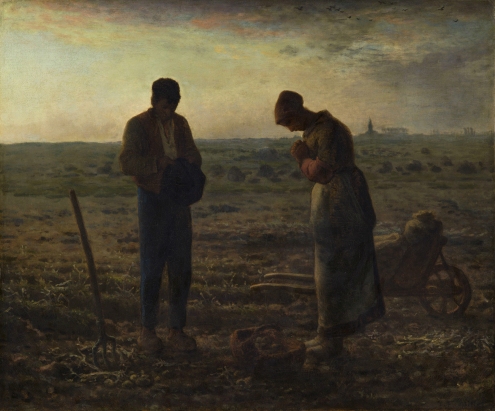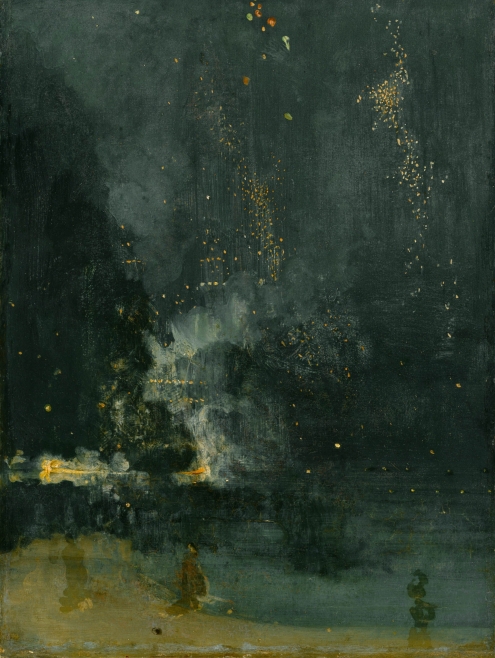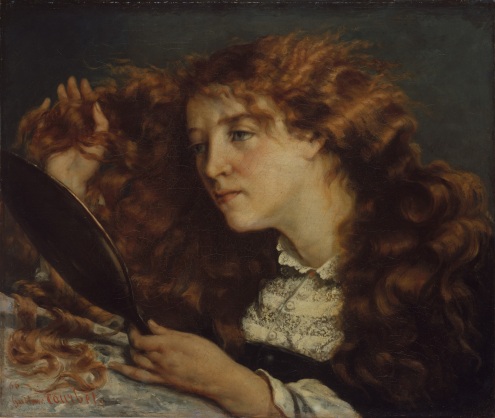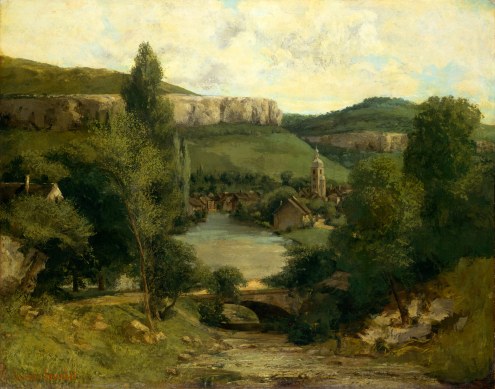Seductive Paris, Part Three: James Abbott McNeill Whistler
[Click here for Part One; here, for Part Two]
Rather extraordinary that Whistler could have painted Wapping in the early 1860s
and Nocturne in Black and Gold: Falling Rocket, circa 1875:
The short answer is “Tonalism.” This article on the site of the Montclair Art Museum enlarges on certain of this art movement’s characteristics:
With its darkish palette, Tonalism countered the high-keyed expression of sunlight and shade in French Impressionism. Tonalism was, in short, one of the swan songs of nineteenth-century American academicism. Yet, paradoxically, it was also assimilated by progressive American Impressionists, and — with its often-ambiguous forms and subjects — even anticipated abstraction.
The understated color in most Tonalist art, or its complete absence, as well as its preternatural evocations, appealed to turn-of-the-century photographers seeking to assert the legitimacy of that medium as a serious art form which could transcend the mere documentation of reality.
More useful definition from The Art Story, especially as it applies to Whistler:
By limiting his color palette and tonal contrast while skewing perspective, Whistler showcased a new compositional approach that emphasized the flat, abstract quality of the painting.
The woman here depicted is Joanna Hiffernan, Whistler’s mistress at the time. She was not quite the shy innocent suggested in this portrait. Whistler’s friends Joseph and Elizabeth Pennell described her thus:
“She was not only beautiful. She was intelligent, she was sympathetic. She gave Whistler the constant companionship he could not do without.”
Whistler himself expresses his admiration rather more freely:
“Her name is Jo Hiffernan, an Irish hellcat, skin like milk. Quick-witted for a woman, and a soul as deep as a well.”
(Quick-witted for a woman, was she? It behooves us to remember that not so long ago, it was perfectly acceptable to toss off this sort of observation disguised by the speaker as a clever bon mot.)
This same model was painted by Gustave Courbet circa 1866:
This work inspired the poem “Before the Mirror” by Algernon Swinburne:
I.
WHITE ROSE in red rose-garden
Is not so white;
Snowdrops that plead for pardon
And pine for fright
Because the hard East blows
Over their maiden rows
Grow not as this face grows from pale to bright.Behind the veil, forbidden,
Shut up from sight,
Love, is there sorrow hidden,
Is there delight?
Is joy thy dower or grief,
White rose of weary leaf,
Late rose whose life is brief, whose loves are light?Soft snows that hard winds harden
Till each flake bite
Fill all the flowerless garden
Whose flowers took flight
Long since when summer ceased,
And men rose up from feast,
And warm west wind grew east, and warm day night.II.
“Come snow, come wind or thunder
High up in air,
I watch my face, and wonder
At my bright hair;
Nought else exalts or grieves
The rose at heart, that heaves
With love of her own leaves and lips that pair.“She knows not loves that kissed her
She knows not where.
Art thou the ghost, my sister,
White sister there,
Am I the ghost, who knows?
My hand, a fallen rose,
Lies snow-white on white snows, and takes no care.“I cannot see what pleasures
Or what pains were;
What pale new loves and treasures
New years will bear;
What beam will fall, what shower,
What grief or joy for dower;
But one thing knows the flower; the flower is fair.”III.
Glad, but not flushed with gladness,
Since joys go by;
Sad, but not bent with sadness,
Since sorrows die;
Deep in the gleaming glass
She sees all past things pass,
And all sweet life that was lie down and lie.There glowing ghosts of flowers
Draw down, draw nigh;
And wings of swift spent hours
Take flight and fly;
She sees by formless gleams,
She hears across cold streams,
Dead mouths of many dreams that sing and sigh.Face fallen and white throat lifted,
With sleepless eye
She sees old loves that drifted,
She knew not why,
Old loves and faded fears
Float down a stream that hears
The flowing of all men’s tears beneath the sky.[1869]
There is a kind of magic here, I think.
In my hastily scribbled notes, I’ve written three phrases uttered by our lecturer: “no narrative, no story, no point.” I’m not sure which work she was referring to.
For more on Whistler, see the Heilbrunn Timeline of Art History, on the Met’s site.
Adventures in art history: Seductive Paris, Part Two
French naturalism was a direct outgrowth of the realist movement in art. The distinction between the two is rather subtle; ergo, I’ll direct you to the relevant entry in the Visual Arts Encyclopedia.
Ms Billman cited Jules Bastien-Lepage as one of the main exponents of naturalism. I was thrilled to hear that name, as I knew what was about to appear on the screen. And sure enough:
I first saw this painting on my initial visit to the Metropolitan Museum of Art. I was eight years old. I already knew the extraordinary story of the Maid of Orleans. Seeing her brought to life in this way before my eyes – I was stunned.
It turns out that this work is somewhat of an anomaly in Bastien-Lepage’s oeuvre. As an artist in the realist/naturalist mode, he produced relatively little in the way of “history painting” or religious subjects. Here are several of his other paintings:
I’ve always wondered why Bastien-Lepage’s works were so rarely encountered elsewhere. I now know that this was due to the sad fact of his early death. According to the French language site “LES SECONDES AU TEMPS DES PEINTRES XIXEME” he died of stomach cancer at the age of 36.
Ms Billman provided a fascinating detail concerning the Joan of Arc painting. It seems that Joan never claimed to have actually seen the saints who spoke to her – only to have heard them. Hence their appearance behind her as she gazes, transfixed, into the middle distance.
I’ve never ceased to be fascinated by Joan’s story. Books about her appear fairly regularly. I can recommend Joan of Arc: A Life Transfigured by Kathryn Harrison (2014). 
Adventures in Art History, Part One: ‘Seductive Paris’
In which your intrepid faithful blogger and Jean, her equally intrepid friend and fellow art lover, commence their journey toward a Certification in World Art History, to be bestowed by the Smithsonian Associates, the educational arm of Washington’s illustrious Smithsonian Institution.
Alas, the day did not start out well. Our train, scheduled to leave at 7:59 AM, did not arrive until almost 9:30. Coincidentally, this was the exact time that our class – our very first one in the program – was scheduled to begin. As the train finally appeared in the distance, I could not help exclaiming, “Oh look! There comes a chugging giant, traveling on these tracks at which we’ve been staring in frustration for an hour and a half! I believe it is a…Can it be..Yes!”
And so it went…
We arrived, panting but barely an hour late, at the Ripley Center, an odd little edifice on the Smithsonian campus where the class was being held.  At least, it seemed little, until we journeyed down two floors and found ourselves in an unexpectedly vast underground space.
At least, it seemed little, until we journeyed down two floors and found ourselves in an unexpectedly vast underground space.
But this was no time to stand gaping! We made for the Lecture Hall and were directed to the balcony, where we settled ourselves, whipped out our notebooks, and as the lecturer held forth about Realism in art history, started scribbling madly. (Everyone around us was doing the same.)
My immediate first thought: I love this!
The program was called Seductive Paris. Our lecturer was Bonita Billman, who teaches art history at Georgetown University’s School of Summer and Continuing Studies. Ms Billman was knowledgeable, discursive, and witty. She possessed a large fund of anecdotes which greatly enhanced her presentation, which consisted of four lectures. They were as follows: French Teachers and American Students; Summers in the Country: American Painters in Brittany and Normandy; Domestic Bliss: Painters of Genre Scenes; and Impressionism in America. All the while Ms Billman was sharing her expertise with us, one gorgeous slide after another appeared on the screen beside and above the podium where she stood. Some of the art work was known to me; most was not. I wrote at frantic speed (and in very low light), trying to get down the names of paintings and artists that I particularly wanted to remember.
There is simply no way I can reproduce here the vast content that constituted these talks. It was akin to condensing an entire semester of art history into one day’s proceedings. So what follows is a partial recapitulation of what was covered in the morning.
When Jean and I got to the lecture, Ms Billman was discussing Gustav Courbet, an artist of out sized genius with an ego to match. This pleased me, as I recalled the stunning exhibit of his works that I’d seen at the Metropolitan Museum of Art eight years ago.
Ms Billman highlighted The Stone Breakers (1850), which was destroyed during World War Two:
Courbet was in the vanguard of realist painters. These artists turned away from portraits of the aristocracy and royalty, and of historical and mythological subjects. Instead, they sought to depict people one might encounter in the ordinary course of life, laborers and peasants being chief among these. Jean-Francois Millet was also in this group:

The Angelus, ca 1859
Our lecturer spoke about the Barbizon School and the artists associated with it. These artists were drawn to natural surroundings, and to their depiction on canvas.The Forest of Fontainebleau was their chief inspiration:
Despite differing in age, technique, training, and lifestyle, the artists of the Barbizon School collectively embraced their native landscape, particularly the rich terrain of the Forest of Fontainebleau. They shared a recognition of landscape as an independent subject, a determination to exhibit such paintings at the conservative Salon, and a mutually reinforcing pleasure in nature.
From “The Barbizon School: French Painters of Nature,” by Dita Amory
This group of artists had its counterpart in what is sometimes referred to as the American Barbizon School. Ms Billman emphasized three painters associated with this movement: William Morris Hunt, Winslow Homer, and Theodore Robinson.
For a time, William Morris Hunt and his brother Richard Morris Hunt shared an apartment in Paris, hard by the Ecole Des Beaux Arts. Writes David McCullough: “From the training and inspiration each of the brothers was to experience in the next several years in France would come great strides for each in his work.” (This quote comes from The Greater Journey: American in Paris, a book I highly recommend.)
***************************
Late in 1866, motivated probably by the chance to see two of his Civil War paintings at the Exposition Universelle, [Winslow] Homer had begun a ten-month sojourn in Paris and the French countryside. While there is little likelihood of influence from members of the French avant-garde, Homer shared their subject interests, their fascination with serial imagery, and their desire to incorporate into their works outdoor light, flat and simple forms (reinforced by their appreciation of Japanese design principles), and free brushwork.
From an essay on Winslow Homer by H. Barbara Weinberg, Department of American Paintings and Sculpture, The Metropolitan Museum of Art. Weinberg opens this essay with the following statement: “Winslow Homer (1836–1910) is regarded by many as the greatest American painter of the nineteenth century.” It’s not hard to see why.
****************************
Like William Morris Hunt, Theodore Robinson was born in Vermont. He traveled to Paris, Venice, and Bologna, returning to America in 1879. Five years later, he returned to France, where he became part of the artists’ colony that had formed around Monet at his house and garden in Giverny.
Robinson returned to America in 1892. He had intended to go back to France once again. Instead, in 1896, while in New York City, he succumbed to an acute asthma attack. He was 43 years old.
There’s more to come on ‘Seductive Paris.’



























